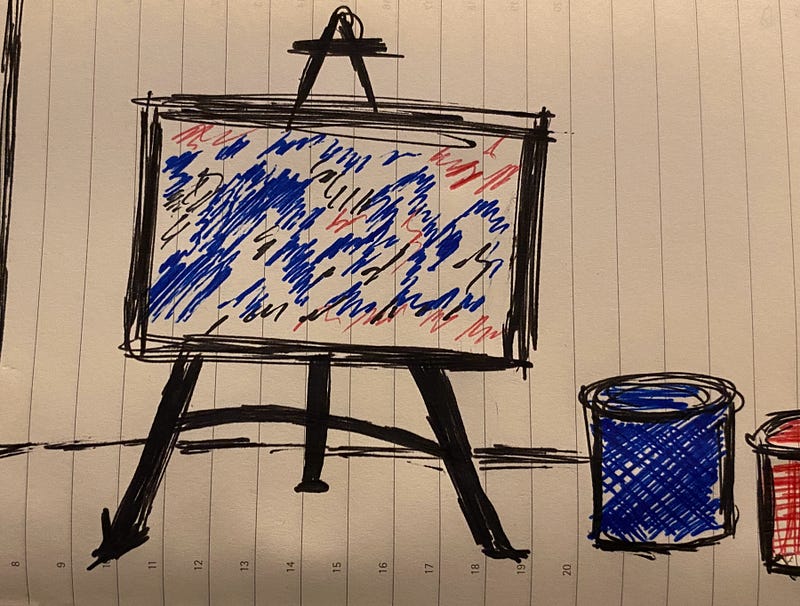Embracing Drawing as a Complement to Your Writing Journey
Written on
Chapter 1: The Joy of Combining Drawing and Writing
For many, the act of drawing can seem daunting, yet it doesn’t have to be a flawless creation. Much like writing, where not every piece needs to be a masterpiece, doodling can serve as an incredible companion to storytelling.
As I navigate my writing journey, I’ve found myself reflecting on the idea of freehand drawing as a means to enrich my narratives. I’ve always identified as a casual doodler, whether I’m in a classroom, waiting for a meeting to commence, or simply passing time during a slow day at the office. My journal and pen often become my canvas for spontaneous creativity.
Now, as I embark on my writing endeavors, I’ve entertained the somewhat ambitious notion of practicing my drawing skills concurrently. Surprisingly, I’ve encountered several established writers who have expressed interest in exploring their artistic side, which has been incredibly encouraging.
This has led me to ponder the advantages of honing drawing skills, whether through traditional methods or digital tools (and just to clarify, I’m not referring to AI-assisted art). The potential benefits of drawing can significantly enhance your writing journey.
Currently, I’m committed to producing a hand-drawn illustration to accompany each piece I create. It's a challenge, but perhaps that’s what makes it enjoyable. I’m testing my resolve to ensure I follow through with my intentions.
However, it’s still quite early in this endeavor. Ideally, I would sketch my images simultaneously with drafting the headings of my articles. I prefer a logical flow as I write, although that doesn’t always occur. Often, a story concept emerges along with a vague image I’d like to illustrate. Yet, just as the title of an article becomes clearer after completing the writing, the theme and accompanying image often crystallize only at the story's conclusion.
This presents a unique challenge. Picture this: after dedicating hours to refine your message, resisting the urge to step away from your desk, you finally craft a suitable title and subtitle. With just an illustration needed, the urge to publish becomes overwhelming, especially when there are countless ready-made images available at your fingertips.
Your phone’s gallery likely holds a photo or two that could fit perfectly. Naturally, there’s a strong temptation to hit publish right away, allowing yourself a break or transitioning to the next task in your day. This is a familiar scenario for me.
At this final juncture, I often feel drained and frustrated for committing to this additional step, which delays my publication and interferes with my schedule. Yet, once I complete the drawing, there’s a profound relief in having honored that commitment.
So, if you’re contemplating enhancing your articles with your own illustrations to distinguish your work amidst a plethora of talent, I urge you to take the plunge. Begin by writing, and then let your creativity flow onto the page through drawing!
This reflection is inspired by a remarkable writer whom I greatly admire. I won’t disclose their name without consent, but I felt it essential to acknowledge their influence should they come across this piece.
Thank you for taking the time to read my thoughts.
Did you find this piece enjoyable? Your feedback would be greatly appreciated. Conversely, if it didn’t resonate with you, I’d also value your thoughts.
Thanks for being part of this journey.
— Daniel
Section 1.1: The Intersection of Art and Narrative
Drawing can serve as a powerful tool in storytelling, enhancing the reader's experience and creating a more immersive narrative.

Subsection 1.1.1: Overcoming Creative Blocks
When faced with creative blocks, drawing can provide a refreshing outlet, helping to stimulate ideas and spark inspiration.
Chapter 2: Practical Steps to Integrate Drawing into Writing
To fully appreciate the benefits of combining drawing with writing, consider exploring various techniques that can facilitate this integration.
The first video, "How To Make A Drawing That Tells A Story," delves into methods for creating illustrations that enhance your narrative and resonate with readers.
The second video, "How to Convey a Message or Story With Your Art," discusses effective ways to communicate themes through your artistic expressions.